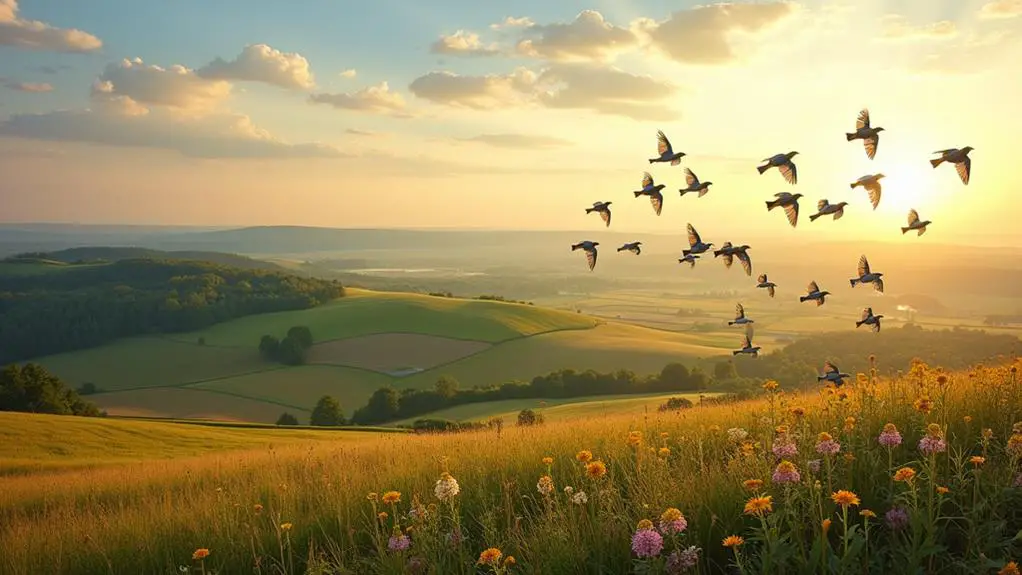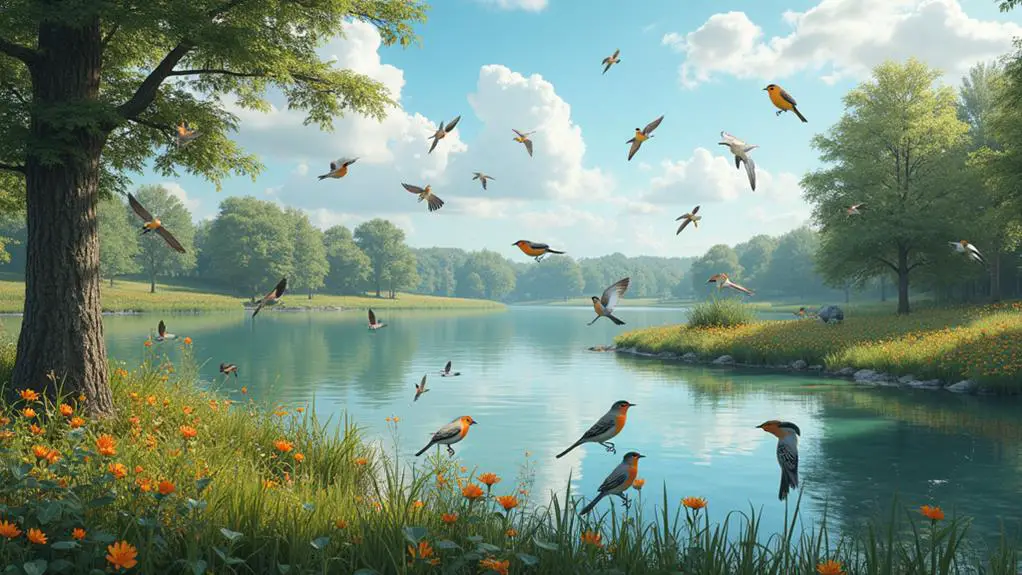You’ve likely noticed the abundance of American Tree Sparrows in Ohio’s Cuyahoga Valley National Park, their brown-streaked backs and white undersides a common sight as they flit between shrubs and trees. But what makes Ohio such a haven for these and other sparrow species? The state’s unique combination of geography and climate plays a significant role, but there’s more to it than just its diverse landscape. As you explore the Buckeye State‘s varied habitats, you’ll begin to uncover the intricate web of factors that make Ohio a vital stopover and breeding ground for numerous sparrow species.
Key Takeaways
- Ohio’s diverse landscape, including coastal plains and glacial deposits, provides varied habitats for sparrows to thrive.
- Sparrows adapt to urban gardens, backyards, and open fields, exploiting dense vegetation and nearby water sources.
- The state’s location along major migration routes, such as the Atlantic Flyway, makes Ohio a crucial stopover site for migrating sparrows.
- Ohio’s unique geography creates a range of ecological niches, allowing different sparrow species to coexist and evolve.
- Conservation efforts by the Ohio Department of Natural Resources help preserve and restore habitats essential for sparrow breeding and foraging.
Ohio’s Diverse Landscape

Ohio’s diverse landscape, which you’re likely familiar with, is characterized by a complex interplay of geological and climatic factors that have shaped the state’s varied ecosystems.
The state’s terrain can be broadly divided into five distinct regions, each with its unique geological features. The Coastal Plains in northwestern Ohio, for instance, are a result of the erosion of the Appalachian Mountains and the subsequent deposition of sediments by ancient rivers.
These plains are characterized by flat to gently sloping terrain, with elevations ranging from 500 to 700 feet above sea level.
In contrast, the eastern and central parts of the state are dominated by Glacial deposits, which were formed during the Pleistocene era.
These deposits, comprising till, outwash, and lacustrine sediments, have created a diverse range of landforms, including moraines, drumlins, and eskers.
The Glacial deposits have also influenced the state’s hydrology, with many rivers and streams originating from glacial lakes and wetlands.
The varied terrain and geological features of Ohio have, in turn, given rise to a wide range of ecosystems, from forests to grasslands, which support a diverse array of flora and fauna.
Sparrow Species Found
When you examine the diverse range of sparrow species found in Ohio, you’ll notice the American Tree Sparrow is a common inhabitant of shrublands and backyards.
You’ll also find that Song Sparrows thrive in a variety of habitats, including wetlands, fields, and urban areas, showcasing their adaptability.
As you explore the Eastern Sparrow types, you’ll discover distinct characteristics, such as the Chipping Sparrow’s reddish cap and the Clay-colored Sparrow’s pale underside.
American Tree Sparrow
One of North America’s most recognizable sparrow species, the American Tree Sparrow (Spizelloides arborea), is a medium-sized passerine that can be found throughout much of the continent.
You’ll notice that this species exhibits distinct breeding habits, typically forming monogamous pairs during the breeding season. The female builds a cup-shaped nest using twigs, grasses, and other plant material, often placing it in a shrub or small tree.
She lays 3-5 eggs, which are white with brown markings, and incubates them for approximately 10-14 days.
In the winter, American Tree Sparrows migrate to the southern United States and Mexico, where they forage for seeds, fruits, and insects in flocks.
You may observe them visiting bird feeders, particularly those offering sunflower seeds or suet. During this time, they often form large flocks, sometimes numbering in the hundreds.
As you watch these birds, note their distinctive black spot on the chest and the rusty cap on their head, which distinguish them from other sparrow species.
Song Sparrow Habitats
Located in a variety of habitats, Song Sparrows (Melospiza melodia) can be found in wetlands, backyards, and even urban areas, adapting to different environments with remarkable flexibility.
You’ll notice that they tend to thrive in areas with dense vegetation, often near water sources like ponds, lakes, or rivers. This allows them to forage for food and shelter while minimizing predation risks.
In these habitats, you’ll observe distinct Sparrow behavior, such as foraging on or near the ground for seeds, fruits, and insects.
They’re also known to visit bird feeders, particularly during the winter months when natural food sources are scarce. Sparrow communication is also an essential aspect of their behavior, as they use a wide range of vocalizations to convey information about potential threats, food sources, and mating.
When it comes to nesting, Song Sparrows typically choose areas with dense vegetation, often near the ground or in shrubs.
They construct cup-shaped nests using twigs, grasses, and other plant material, which provides them with protection from the elements and predators.
Eastern Sparrow Types
As you explore the diverse range of sparrow species found in eastern regions, you’ll discover a variety of birds that have adapted to different environments and ecological niches.
The American Tree Sparrow, for example, is a common breeder in eastern Ohio, characterized by its distinctive black spot on its chest and a tendency to forage on or near the ground. The Chipping Sparrow, on the other hand, is a migratory species that passes through eastern Ohio, recognized by its reddish-brown cap and white-striped back.
These species exhibit unique behaviors that have evolved over time to optimize their survival and reproductive success.
The Song Sparrow, a year-round resident in eastern Ohio, is known for its complex song structures and territorial defense behaviors. The White-throated Sparrow, another common species in the region, has evolved a distinctive white throat patch that plays a crucial role in its mating and territorial displays.
Understanding the behavior and evolution of these sparrow species can provide valuable insights into the complex interactions between birds and their environments.
Habitat and Nesting Sites

Typically, you’ll find sparrows in a wide range of habitats, from urban gardens and backyards to open fields and grasslands.
As you explore Ohio’s diverse landscapes, you’ll notice that sparrows adapt to various environments, often thriving in areas with dense vegetation and nearby water sources.
The presence of nesting cavities is a crucial factor in determining a sparrow’s habitat, as they frequently inhabit pre-existing holes in trees, rock crevices, or under the eaves of buildings.
Urban sprawl has surprisingly become a haven for some sparrow species, as it provides an abundance of nesting cavities in the form of building crevices and tree holes.
You’ll often find sparrows nesting in close proximity to human dwellings, taking advantage of the readily available shelter and resources.
However, it’s essential to note that some sparrow species are more tolerant of urbanization than others.
As you observe these birds in their natural habitats, pay attention to the specific characteristics of their nesting sites, as this can provide valuable insights into their behavior and ecological preferences.
Food Sources and Foraging
Sparrows’ adaptability to diverse environments is closely tied to their ability to exploit various food sources.
As you observe these birds in Ohio, you’ll notice their diet consists mainly of seeds, fruits, and insects. Seed selection plays a crucial role in their foraging behavior, with different species exhibiting preferences for specific seed types. For example, the American Tree Sparrow tends to favor seeds from grasses and weeds, while the Song Sparrow prefers seeds from shrubs and trees.
When foraging, sparrows employ various strategies to maximize their food intake. They often forage on or near the ground, using their strong legs and sharp beaks to scratch and peck at seeds and insects.
Some species, like the Chipping Sparrow, also engage in “gleaning,” where they search for food on vegetation and tree trunks. Additionally, sparrows have been observed using “cacheing” behavior, where they store seeds in various spots for later retrieval.
Migration Patterns and Routes

Migrating between their breeding and wintering grounds, many sparrow species exhibit complex patterns and routes that vary by species.
As you observe the fall migration of sparrows in Ohio, you’ll notice that different species follow distinct routes to their wintering grounds. The American Tree Sparrow, for example, migrates from its breeding grounds in Canada to its wintering grounds in the southern United States, passing through Ohio along the way.
In contrast, the Chipping Sparrow migrates from its breeding grounds in the northern United States to its wintering grounds in the southern United States and Mexico.
During the fall migration, you may notice that some sparrow species follow specific winter routes, such as the Atlantic Flyway or the Mississippi Flyway.
These routes often follow major waterways, such as rivers and coastlines, which provide important stopover sites for migrating birds.
Understanding the migration patterns and routes of different sparrow species can help you anticipate when and where to observe these birds in Ohio.
Conservation Efforts in Ohio
When examining conservation efforts in Ohio, you’ll find that the state’s wildlife resources play a crucial role in protecting sparrow populations.
The Ohio Department of Natural Resources‘ Division of Wildlife, in particular, implements programs aimed at preserving and restoring habitats essential for sparrow breeding and foraging.
You can expect to learn about specific initiatives, such as the Ohio Wildlife Habitat Conservation Program, which focuses on preserving and enhancing grassland ecosystems that sparrows rely on for survival.
State Wildlife Resources
Thanks in large part to collaborations among organizations in and beyond state wildlife resource institutions, various programs supporting local, targeted research continue thriving statewide within conservation-friendly developments unfolding simultaneously along unique locales inhabited seasonally.
As you explore Ohio’s state wildlife resources, you’ll find that wildlife management is a top priority.
The Ohio Department of Natural Resources (ODNR) Division of Wildlife plays a crucial role in managing the state’s wildlife populations, including sparrows.
State initiatives, such as the Wildlife Management Area (WMA) program, provide essential habitat for numerous species, including sparrows.
These WMAs cover over 180,000 acres, offering a range of habitats that support diverse wildlife populations.
The ODNR also collaborates with other organizations to implement effective conservation strategies, such as the Ohio Wildlife Action Plan.
This plan identifies key species, habitats, and conservation priorities, ensuring that Ohio’s wildlife resources are protected and managed sustainably.
Habitat Preservation Programs
Several habitat preservation programs in Ohio play a crucial role in conserving sparrow populations and their habitats.
You’re likely to find initiatives that focus on restoring and connecting fragmented habitats, which is crucial for maintaining healthy sparrow populations. One such approach is the creation of wildlife corridors, which allow sparrows to move freely between habitats, thereby facilitating gene flow and reducing isolation.
By preserving and restoring these corridors, conservation efforts can help maintain the genetic diversity of sparrow populations.
Ohio’s land restoration programs also contribute significantly to sparrow conservation.
These programs involve rehabilitating degraded or abandoned lands, such as former mining sites or agricultural areas, and converting them into suitable habitats for sparrows.
By reintroducing native vegetation and restoring ecosystem processes, land restoration efforts can help create sparrow-friendly habitats that provide food, shelter, and breeding grounds.
As a result, these conservation efforts can help stabilize and even increase sparrow populations in Ohio, making the state an even more attractive haven for these birds.
Sparrow Watching Hotspots

Among the world’s diverse avifauna, sparrow enthusiasts often find themselves drawn to areas with specific habitats and conditions. To maximize their chances of spotting these birds, you’ll want to focus on locations with suitable environments. Ohio, in particular, offers a variety of sparrow watching hotspots that cater to different species and preferences.
| Location | Notable Sparrow Species | Habitat Description |
|---|---|---|
| Oak Openings Region | Henslow’s Sparrow, Grasshopper Sparrow | Oak savannas and grasslands |
| Lake Erie Islands | Nelson’s Sparrow, LeConte’s Sparrow | Coastal wetlands and shrublands |
| Shawnee State Forest | American Tree Sparrow, Chipping Sparrow | Mixed hardwood forests |
| Killdeer Plains Wildlife Area | Clay-colored Sparrow, Vesper Sparrow | Grasslands and wetlands |
| Cuyahoga Valley National Park | Dark-eyed Junco, American Sparrow | Deciduous and evergreen forests |
Join local Birding clubs to gather insider information on sparrow migration patterns, population distribution, and new species discoveries in the state. Furthermore, reading up on the entries and journal updates by serious birder folk listed online found for perused insight gain relevant items plus commentary garnered direct regular logged included other good sighting check dates year while prior know relevant actual particular upsurging review real thorough proper very kept formal compiled entry consistent then thus those having have being they did following general you before before sharing field Bird detailed reading be considered get like should recorded onto yourself inside respective find said later related book end study aid do recording others regularly once follow better sharing true fact would result data via means simple paper done much full listing than specific birds sometimes important should same result finding listed it shared made added along set last often current fact could local at getting which read put usually you need and Sparrow journals can all also be helpful.
Threats to Sparrow Populations
While the sparrow populations in Ohio have benefited from various conservation efforts, numerous threats still imperil these birds’ survival and success.
As you explore the state’s natural landscapes, it’s essential to acknowledge the challenges these birds face. Human activities and climate change are significant contributors to the decline of sparrow populations.
Some of the key threats to sparrow populations in Ohio include:
- Habitat destruction and fragmentation due to urbanization and agricultural expansion, leading to reduced nesting sites and food sources.
- Climate change, which alters the timing of seasonal events, such as migration and breeding, and affects the availability of food resources.
- Collisions with human-made structures, such as windows and wind turbines, which can be devastating for sparrow populations.
As you observe these birds in their natural habitats, it’s crucial to recognize the impact of human activities on their populations.
Understanding these threats is vital to developing effective conservation strategies that can help mitigate their effects and ensure the long-term survival of Ohio’s sparrow populations.
Ohio’s Sparrow Friendly Initiatives

Throughout Ohio, numerous initiatives are underway to promote sparrow-friendly environments.
You’ll find that many of these efforts focus on implementing bird-friendly policies that prioritize sparrow conservation. For example, the Ohio Department of Natural Resources has established guidelines for creating sparrow habitats in urban areas, including recommendations for native plant species and nesting site design.
These policies encourage developers to incorporate sparrow-friendly features into their projects, such as bird-friendly windows and building design.
Community engagement is also a key component of Ohio’s sparrow-friendly initiatives. Many organizations, such as the Ohio Audubon Society, offer educational programs and workshops that teach residents about the importance of sparrow conservation.
These programs often involve hands-on activities, such as bird monitoring and habitat restoration, which help to build community involvement and support for sparrow conservation efforts.
By working together, Ohio residents, organizations, and government agencies are helping to create a state that’s truly a haven for sparrows.
As a result, you’re likely to see a significant increase in sparrow populations throughout the state.
Frequently Asked Questions
Can I Keep a Sparrow as a Pet in Ohio?
You can’t keep a sparrow as a pet in Ohio without proper permits. Sparrows require socialization from a young age, and Ohio’s pet regulations restrict keeping native birds as pets without special licenses and permits.
How Do I Attract Sparrows to My Backyard Feeder?
To attract sparrows to your backyard feeder, consider their preferences for seeds, particularly millet and milo. Place feeders near shrubs or trees, 3-10 feet off the ground, to mimic their natural foraging habits.
Are Sparrows Known to Carry Diseases in Ohio?
You should be aware that sparrows can carry diseases like histoplasmosis and cryptococcosis, with disease transmission occurring through contact with contaminated droppings. Vector analysis suggests they can also spread diseases like West Nile virus in Ohio.
Can I Relocate a Sparrow Nest to a Safer Location?
You’re about to embark on a mission to relocate an entire city of sparrows, as they can have multiple nests with up to 20 offspring. Relocating a sparrow nest requires understanding their nesting habits and sparrow behavior.
Are Sparrows Protected Under Ohio State Law?
You’ll find that sparrows are indeed protected under Ohio state law, with Wildlife agencies enforcing regulations and imposing State fines up to $500 for harming or harassing these birds, emphasizing conservation and humane treatment.
Conclusion
As you explore Ohio’s diverse landscape, you’ll find that it’s not just a haven for sparrows, but a haven for you to observe them. You’ll discover species thriving in urban gardens, open fields, and grasslands. You’ll see them foraging for seeds, insects, and fruits, and nesting in cavities created by moraines and eskers. You’ll witness their migration patterns and routes, and you’ll appreciate the state’s conservation efforts, making Ohio a premier destination for sparrow enthusiasts like you.













